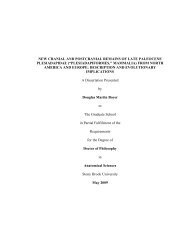Changes in nearest-neighbor associations in a captive group of ...
Changes in nearest-neighbor associations in a captive group of ...
Changes in nearest-neighbor associations in a captive group of ...
You also want an ePaper? Increase the reach of your titles
YUMPU automatically turns print PDFs into web optimized ePapers that Google loves.
276 McCann and Rothman<br />
based on the fact that they are tw<strong>in</strong>s or the fact that they are the same sex. Female<br />
I1’s <strong>nearest</strong> <strong>neighbor</strong>s were related males I4 and I5 overwhelm<strong>in</strong>gly more than female<br />
<strong>in</strong>fants I2 and I3. Moreover, I1 was placed <strong>in</strong> the same sleep<strong>in</strong>g enclosure with<br />
I2 every night for their first year <strong>of</strong> life; therefore, based on familiarity, it was expected<br />
that they would associate more with each other but that was not the case.<br />
Influence <strong>of</strong> Behavioral Pr<strong>of</strong>iles on Association Patterns<br />
It is likely that similar behavioral pr<strong>of</strong>iles <strong>of</strong> adults and <strong>in</strong>fants may have been<br />
as important <strong>in</strong> produc<strong>in</strong>g the association patterns observed as were age, sex, or k<strong>in</strong><br />
relationships. It is noteworthy that the silverback and his <strong>of</strong>fspr<strong>in</strong>g exhibited the<br />
same behavioral <strong>in</strong>dices (cautious, apprehensive, and protective) as did females F2<br />
and F3 and their <strong>of</strong>fspr<strong>in</strong>g (sociable, playful, and permissible) and therefore had a<br />
greater aff<strong>in</strong>ity toward one another [behavioral <strong>in</strong>dices per Gold and Maple, 1994].<br />
Infants I2 and I3 displayed <strong>in</strong>dependence and <strong>in</strong>tegrated well with<strong>in</strong> the <strong>group</strong>, possibly<br />
caus<strong>in</strong>g a higher probability <strong>of</strong> <strong>in</strong>teraction with all <strong>group</strong> members. The similarities<br />
<strong>in</strong> behavioral pr<strong>of</strong>iles may be a major factor <strong>in</strong>fluenc<strong>in</strong>g the association patterns<br />
described <strong>in</strong> this study. However, it is also important to note that behavioral traits<br />
have a genetic component [Wilson, 1975], and therefore, the similar traits seen <strong>in</strong><br />
related <strong>in</strong>dividuals may provide a basis for k<strong>in</strong> recognition.<br />
In sum, it is difficult to determ<strong>in</strong>e whether it was solely the genetic relatedness<br />
between adults and <strong>in</strong>fants or the similar behavioral pr<strong>of</strong>iles exhibited by related <strong>in</strong>dividuals<br />
that primarily drove the patterns <strong>of</strong> <strong>associations</strong> observed. Likewise, the age and<br />
sex <strong>of</strong> <strong>in</strong>dividual’s may have also <strong>in</strong>fluenced the outcome <strong>of</strong> behaviors. The results <strong>of</strong><br />
this study support that k<strong>in</strong> relatedness and similar behavioral pr<strong>of</strong>iles are important variables<br />
<strong>in</strong>fluenc<strong>in</strong>g patterns <strong>of</strong> association <strong>in</strong> gorillas. Nevertheless, although the sample<br />
size and conditions <strong>of</strong> this study cannot unequivocally confirm that k<strong>in</strong> recognition was<br />
an important factor operat<strong>in</strong>g <strong>in</strong> this case, the results do lend strong support to the success<br />
<strong>of</strong> us<strong>in</strong>g related <strong>in</strong>dividuals <strong>in</strong> <strong>in</strong>fant gorilla <strong>in</strong>troductions.<br />
CONCLUSION<br />
The <strong>in</strong>tegration <strong>of</strong> the five hand-reared <strong>in</strong>fants <strong>in</strong>to the <strong>group</strong> <strong>of</strong> adults described<br />
<strong>in</strong> this study was successful and without <strong>in</strong>cident. Additionally, it was the<br />
first <strong>in</strong>troduction at the BZ/WCP that <strong>in</strong>cluded <strong>in</strong>fants younger than 1.6 years old.<br />
Based on the results <strong>in</strong> this study, the follow<strong>in</strong>g ma<strong>in</strong> conclusions can be made:<br />
The silverback male played a pivotal role <strong>in</strong> the successful <strong>in</strong>tegration <strong>of</strong> the<br />
five <strong>in</strong>fants <strong>in</strong>to the established <strong>group</strong> <strong>of</strong> adults. Although some studies reported that<br />
adult males can respond aggressively toward hand-reared <strong>in</strong>fants, <strong>in</strong> this study, the<br />
male facilitated the <strong>in</strong>troduction process by provid<strong>in</strong>g protection to the <strong>in</strong>fants and<br />
cohesiveness among the <strong>group</strong>.<br />
Adult females showed no change <strong>in</strong> behavior patterns, suggest<strong>in</strong>g their general<br />
acceptance <strong>of</strong> the addition <strong>of</strong> <strong>in</strong>fants <strong>in</strong>to the <strong>group</strong>. Sub-adult female S1 benefited<br />
from the addition <strong>of</strong> <strong>in</strong>fants <strong>in</strong>to the <strong>group</strong> by ga<strong>in</strong><strong>in</strong>g parental experience, <strong>in</strong>creas<strong>in</strong>g<br />
her chances <strong>of</strong> becom<strong>in</strong>g a competent mother.<br />
The five <strong>in</strong>fants associated with one another significantly more <strong>of</strong>ten than with<br />
an adult. Infant gorillas <strong>in</strong> peer <strong>group</strong>s when <strong>in</strong>troduced to adults proved successful.<br />
Be<strong>in</strong>g raised <strong>in</strong> a peer <strong>group</strong> appeared to give the <strong>in</strong>fants a strong sense <strong>of</strong> security<br />
and companionship.






